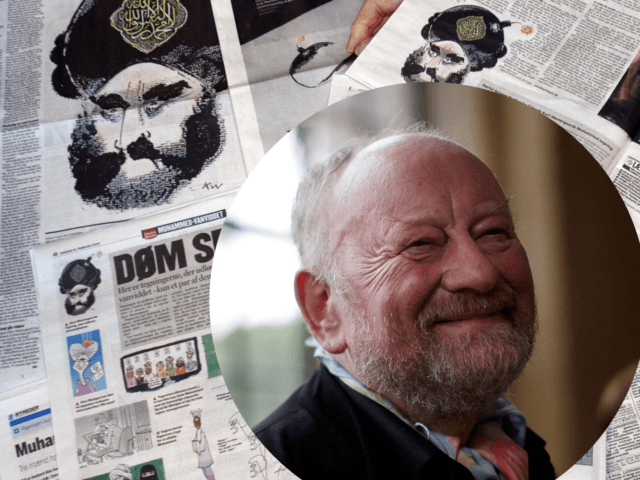Kurt Westergaard, the Danish cartoonist whose caricature of Mohammed sparked a worldwide and bloody backlash from radical Islamists, died peacefully in his sleep at the age of 86-years-old.
Westergaard’s family told Danish daily Berlingske on Sunday that he died in his sleep after a long illness. He is survived by his wife Gitte, their five children, ten grandchildren, and one great-grandchild.
Mr Westergaard had been living under constant protection as a result of death threats from radical Islamic extremists since the publication of a series of his cartoons in the Danish magazine Jyllands-Posten under the headline The Face of Mohammed in 2005.
The reaction to the cartoons in the Islamic world has been described as one of the biggest foreign policy crises for Denmark since the Second World War, with Danish flags and diplomatic offices attacked during international protests which claimed the lives of as many as 200 people in the Islamic world and further afield.
The great Kurt Westergaard died.
He was a brave man. An example for all of us. Rest In peace my friend! #KurtWestergaard pic.twitter.com/TLbqtLaiNB— Geert Wilders (@geertwilderspvv) July 18, 2021
Following the publication of the cartoons, Kurt Westergaard himself became a target for extremist retribution. In 2008, the Danish Security and Intelligence Service (PET) arrested three Tunisian background men for allegedly plotting to kill the cartoonist.
Two years later, Westergaard survived an assassination attempt in which a Somalian man broke into his house with an axe. Mr Westergaard, then seventy-five years old, survived by locking himself in his toilet, which had been converted into a panic room.
In 2011, the would-be assassin was sentenced to ten years in prison, following which he was supposed to be deported forever from Denmark, however, he currently still remains in the country.
According to the obituary from his former magazine, entitled The cartoonist with the lifelong death sentence is dead, Mr Westergaard had attempted to reach out to his attacker shortly before his 85th birthday.
“When you, like me, approach your 85th birthday, there is not much you can achieve for the rest of your life. I do not have hateful thoughts about anyone – not even about him, but unfortunately, he did not want to meet with me,” Kurt Westergaard said at the time.
Islamic Terrorist Who Plotted Danish Newspaper Massacre Released in Sweden https://t.co/bZauajLvBJ
— Breitbart London (@BreitbartLondon) February 1, 2020
In 2015, the cartoonist said that he had no regrets for drawing the caricature of the Islamic prophet, saying: “They say that now we must show tolerance and we must be very careful that we don’t offend our fellow Muslim citizens. But the fact is that it is fear, and that is something very deplorable. Of course, I understand that people are afraid, I am also afraid, but I am more angry than I am afraid.”
Carsten Juste, the former editor for the conservative Jyllands-Posten and Westergaard’s former boss said of his passing: “Kurt was a man of honour. Plain and straight. He had to endure a lot in his time after he had drawn the drawing, which in most places in other media and among many so-called experts was completely misunderstood.”
Juste said that as a result of the backlash, Westergaard was forced into transforming his home into a Danish “Fort Knox”.
“He had to hear a lot of things from well-informed people, and which I perceive as some fucking rich and stupid pigs who attributed to Kurt motives that he did not have at all,” Juste said, adding: “He was called a racist. His family is a motley bunch and is from all sorts of countries of the world. He was in all his attitude and political perception the opposite of all that he was accused of being.”
Westergaard consistently maintained that he had no malice or hatred of Islam, despite the death threats made against him, saying in 2015: “I have no problems with Muslims as a whole, I will always fight for people’s right to have their religion and their beliefs. That is a private matter.”
He said that the cartoons were not meant as a critique of Islam as a whole, but rather on “terrorists who get their spiritual ammunition from parts of the Koran.”
Danish Newspapers Agree to Publish Political Ads with Mohammed Cartoon https://t.co/bQWHdsw3ys
— Breitbart London (@BreitbartLondon) November 3, 2020
Aside from the Islamist backlash, the Danish cartoon controversy also sparked an ongoing debate in Europe about freedom of speech and blasphemy which reverberates to this day.
Six years after the publication of Westergaard’s cartoons, the French satirical magazine published similar caricatures of the Islamic prophet. In January of 2015, two Muslims, Saïd and Chérif Kouachi stormed the Charlie Hebdo offices in Paris, killing 12 people including five cartoonists for the magazine.
Last year, Samuel Paty, a French teacher, was beheaded by a Chechen asylum seeker for showing his class the Charlie Hebdo caricatures during a class on freedom of expression.
In March of this year, a school teacher in Batley in England was suspended after showing the Charlie Hebdo cartoons to his class. The teacher was later forced into hiding after a local Islamic group outed his identity online, he remains in hiding to this day.
Remarking on his role in the battle between Islamic extremism and freedom of speech, Kurt Westergaard said: “I want to be remembered as the one who struck a blow for freedom of speech. But there is no doubt that there is someone who will instead remember me as a satan who insulted the religion of a billion people.”
Pics: Defying Islamists, Giant Image of Mohammed Projected onto French Government Building After Beheading https://t.co/kHOM24XKPA
— Breitbart London (@BreitbartLondon) October 21, 2020
Follow Kurt Zindulka on Twitter here @KurtZindulka

COMMENTS
Please let us know if you're having issues with commenting.